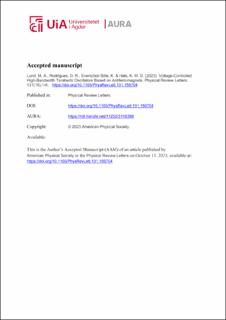| dc.contributor.author | Lund, Mike Alexander | |
| dc.contributor.author | Rodrigues, Davi R. | |
| dc.contributor.author | Everschor-Sitte, Karin | |
| dc.contributor.author | Hals, Kjetil Magne Dørheim | |
| dc.date.accessioned | 2024-02-08T12:27:21Z | |
| dc.date.available | 2024-02-08T12:27:21Z | |
| dc.date.created | 2023-11-13T09:34:00Z | |
| dc.date.issued | 2023 | |
| dc.identifier.citation | Lund, M. A., Rodrigues, D. R., Everschor-Sitte, K. & Hals, K. M. D. (2023). Voltage-Controlled High-Bandwidth Terahertz Oscillators Based on Antiferromagnets. Physical Review Letters, 131(15),1-6. | en_US |
| dc.identifier.issn | 1079-7114 | |
| dc.identifier.uri | https://hdl.handle.net/11250/3116388 | |
| dc.description | Author's accepted manuscript | en_US |
| dc.description.abstract | Producing compact voltage-controlled frequency generators and sensors operating in the terahertz (THz) regime represents a major technological challenge. Here, we show that noncollinear antiferromagnets (NCAFM) with kagome structure host gapless self-oscillations whose frequencies are tunable from 0 Hz to the THz regime via electrically induced spin-orbit torques (SOTs). The auto-oscillations' initiation, bandwidth, and amplitude are investigated by deriving an effective theory, which captures the reactive and dissipative SOTs. We find that the dynamics strongly depends on the ground state's chirality, with one chirality having gapped excitations, whereas the opposite chirality provides gapless self-oscillations. Our results reveal that NCAFMs offer unique THz functional components, which could play a significant role in filling the THz technology gap. | en_US |
| dc.language.iso | eng | en_US |
| dc.publisher | American Physical Society | en_US |
| dc.rights | | * |
| dc.subject | Spinntronikk | en_US |
| dc.subject | Spintronics | en_US |
| dc.title | Voltage-Controlled High-Bandwidth Terahertz Oscillators Based on Antiferromagnets | en_US |
| dc.type | Peer reviewed | en_US |
| dc.type | Journal article | en_US |
| dc.description.version | acceptedVersion | en_US |
| dc.rights.holder | © 2023 American Physical Society | en_US |
| dc.subject.nsi | VDP::Matematikk og Naturvitenskap: 400::Fysikk: 430 | en_US |
| dc.source.pagenumber | 1-6 | en_US |
| dc.source.volume | 131 | en_US |
| dc.source.journal | Physical Review Letters | en_US |
| dc.source.issue | 15 | en_US |
| dc.identifier.doi | https://doi.org/10.1103/PhysRevLett.131.156704 | |
| dc.identifier.cristin | 2195517 | |
| dc.relation.project | Norges forskningsråd: 286889 | en_US |
| dc.relation.project | Norges forskningsråd: 334202 | en_US |
| dc.source.articlenumber | 156704 | en_US |
| cristin.qualitycode | 2 | |
